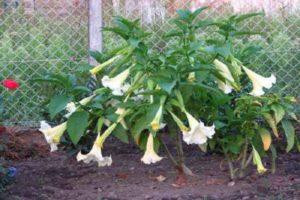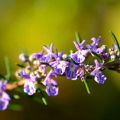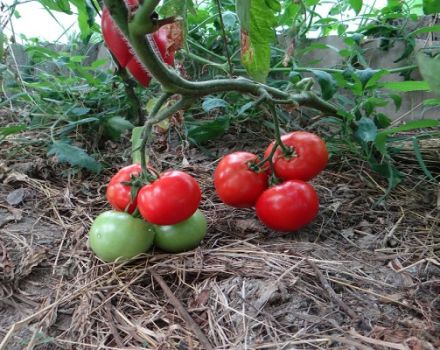Planting and caring for miscanthus in the open field, types and varieties
In the process of arranging the site, there is a desire to beautifully arrange the lawn, reservoirs and flower beds. To decorate the landscape with beautiful greenery, gardeners often choose fluffy miscanthus, the planting and maintenance of which in the open field requires a careful approach. The fan-shaped shoots of this plant are also used by florists to form dry compositions.
Description
Miscanthus is a cereal, found naturally in the subtropical and tropical regions of Africa, Asia and Australia. The popularity of the plant is associated with its long-term decorative effect, since the flower remains attractive until late autumn.
Outwardly, the plant resembles a compact perennial 2-3 m high. The creeping rhizome produces straight stems with long leathery leaves that look like scales. At the end of the shoots there are fan-shaped panicles, consisting of short spikelets and a developed flower.
Varieties and types
There are about 40 varieties of miscanthus in the world. Not all of them are used in horticulture, most are wild-growing and are not found in Russia. The most common types are:
- Chinese;
- sugar-colored;
- giant.
Chinese
The species is characterized by high resistance to winter cold. The plant forms powerful stems up to 3 m high, rather rarely located on a short rhizome. The leaves are scaly narrow and somewhat rough, the longitudinal rib divides them in half. In autumn they take on a red or yellow tint. Panicles collected from single-flowered spikelets are pink, reddish, or silvery. Flowering lasts from August to October.

Flamingo
This variety perfectly tolerates frosts up to 29 ° C, without requiring insulation for the winter. Plant height reaches 2 m. Flowers on panicles of Flamingo Miscanthus are larger and pink in color.
Klein Fountain
Miscanthus of this variety does not grow above 1 m. Panicles of standard size are brownish in color.
Malepartus
It is known for its early flowering. The height of miscanthus is standard - about 2 m. Flowers on panicles are claret, and by autumn they acquire a bright red hue. At this time, the leaves turn from green to golden orange.
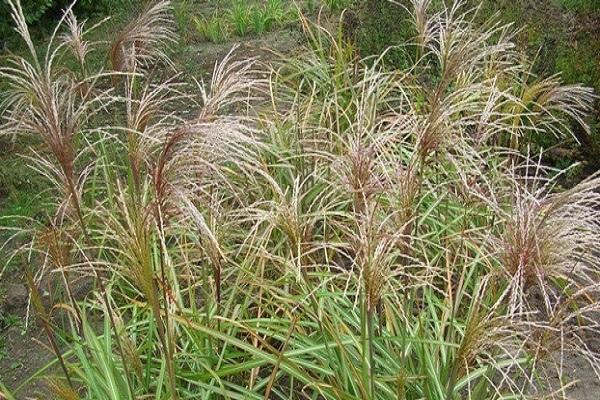
Rotsilber
The main distinguishing feature of this miscanthus variety is the reddish tint of the leaves and panicles.In autumn, at the end of the growing season, they turn rather orange.
Zebrina
This variety is sometimes referred to as Miscanthus Zebrinus. The name is associated with yellow or creamy transverse stripes on narrow leaves. Plant height exceeds 2 m and sometimes requires additional support. The peak of flowering occurs in September, the panicles are distinguished by a brick-red palette.
Variegata
Miscanthus Variegata is distinguished by long leaves with a variegated white-green color. The height of the plant varies within 1.5-2 m. Flowers at the ends of the spikelets have a red tint.
Strictus
A fairly tall variety grows up to 2.7 m. Leaves with green and white stripes are 1.5 cm wide. Panicles at the ends of the stems are loose, the red color of the spikelets is rather pale.
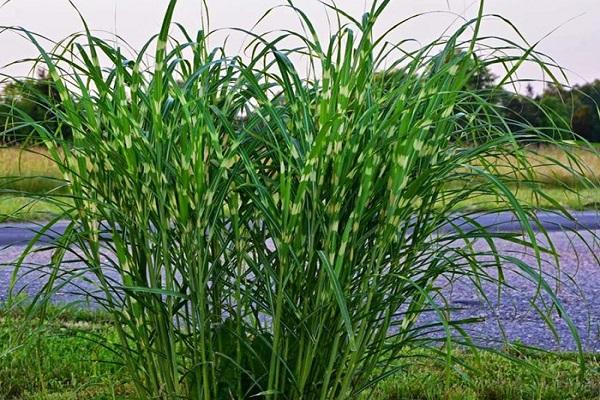
Gold Bar
This slow-growing variety of miscanthus has a maximum height of 1.5 m. The long, narrow leaves are covered with cream stripes. Panicles bloom in August, giving the plant a winey color.
Purpurescens
The height of this variety is not more than 1.5 m. Leaves from grayish-green in autumn turn red-orange. Narrow inflorescences in September have a purple hue, which gradually changes to white.
Gracilimus
The Gracillimus variety has performed well when grown in the shade, where it grows above 2 m. Thin leaves and a rounded bush attract decorators. The bushes bloom in late September, which implies cultivation in the southern regions, the panicles have a reddish tint.
Rother Pfeil
The height of this variety's miscanthus reaches 1.5 m. The leaves turn purple in autumn, and the inflorescences change from reddish-pink to silvery. Flowering lasts from August to October.
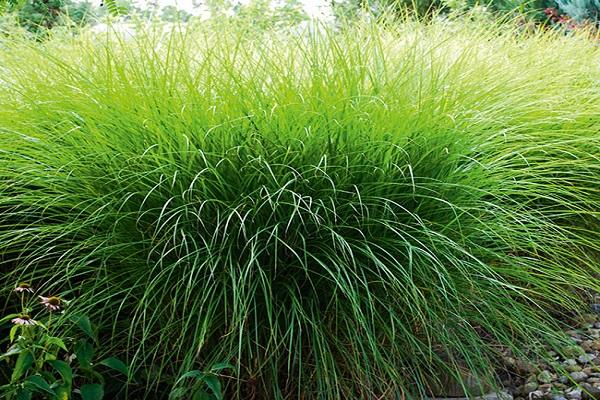
Moning Light
The Morning Light miscanthus variety, or Morning Light, is one of the oldest. The height of the bushes is below average, only about 1.5 m. It blooms in early September, staining spikelets with a pinkish-red color.
Graziella
By the beginning of autumn, the greens of this variety acquire a crimson hue, while the color of the brushes at the ends of the stems is creamy. Graziella is well adapted to the composition of the soil, tolerates winter calmly and is drought tolerant, but intolerant of shading. The height of the plant is small - about 1.5 m.
Silberfeder
The variety is characterized by feathery leaves wider up to 2 cm, which are pinkish at the beginning of the growing season, and become silvery by autumn. Panicles appear on stems in August. The shrub is highly resistant to frost.
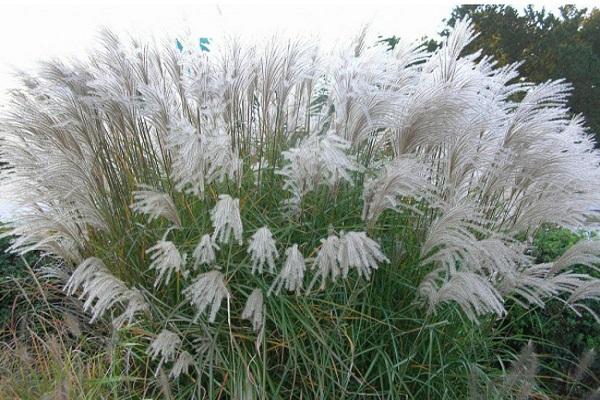
Little Zebra
This variety is rather undersized, since the height of the stems does not exceed 1.2 m. Green leaves have yellow transverse stripes. At the beginning of flowering, the panicles are colored reddish-purple; closer to October, they become creamy.
Ash Foul
Medium-sized miscanthus reaches a height of 1.5-2 m, blooming in September with pinkish-red panicles. The leaves turn purple in autumn.
Adagio
Miscanthus Adagio is a low-growing cereal species. Plant height is about 80 cm. The narrow grayish-silvery leaves turn yellow in autumn. Inflorescences appear in August and gradually turn from pink to creamy white.
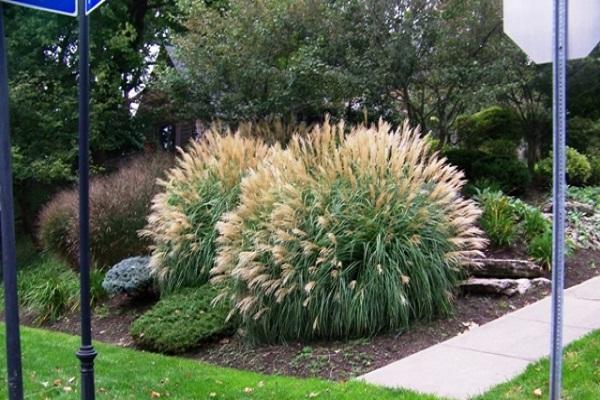
Sugar
A less tall species is sugar-flowered miscanthus. Straight smooth stems do not grow higher than 2 m, on which narrow linear leaves are located. The panicles at the ends of the shoots are pinkish or pale silvery. The more thermophilic miscanthus begins the growing season later, and blooms only in July.
Giant
The species is hybrid, but its exact origin is unknown. Straight stems are not strong and often need support. Long leaves hang from the shoots and have a dark green tint. A longitudinal white rib is located in the center of each. A great advantage of the gigantic miscanthus is its ability to withstand frosts up to 34 ° C.
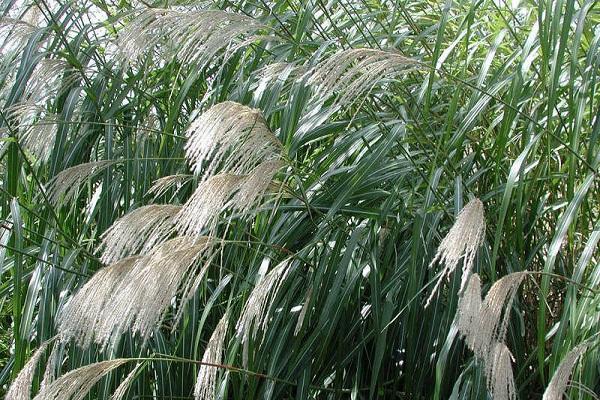
Growing
The main condition for the active growth of Miscanthus is consistent preparation and careful care. Choose suitable soil and quality seedlings for planting. It is also important to prepare the soil and then apply fertilizers in a timely manner, loosen and clean the soil. When growing thermophilic varieties, you should also take care of frost protection..
Choosing a place and landing dates
A place suitable for planting miscanthus should be well lit, even a weak shade will not allow the plant to bloom fully. The site should be located in a lowland so that moisture is retained at the roots. The best option would be the coastline of water bodies. The plant must be protected from drafts and blowing winds. The optimal time to plant miscanthus is late March and ends in mid-May. The snow should have completely melted by this time, and the ground should warm up well.
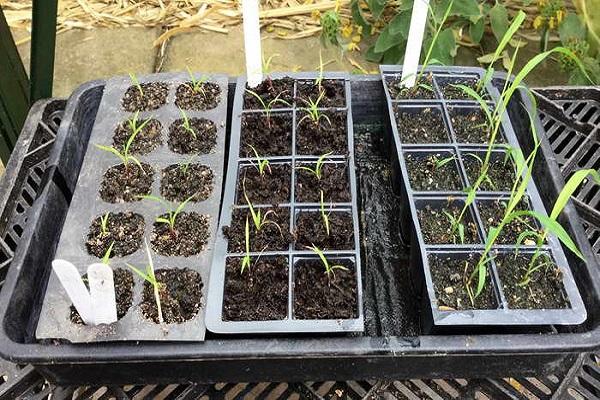
Soil preparation
The soil for miscanthus must meet the following characteristics:
- neutral or slightly acidic;
- medium density;
- sandy loam, loamy, peat, soddy.
Before planting miscanthus, the site must be dug up, freed from weeds, and organic fertilizers must be applied.
How to plant
Technology for planting miscanthus in open ground:
- Water the seedlings abundantly in containers with warm water.
- Prepare planting holes with a depth of about 0.2 m at a distance of at least 1 m from each other.
- Limit the walls of the holes with slate or planks to control the growth of the bush.
- If necessary, lay drainage on the bottom of the hole.
- Mix the extracted soil with peat, sod, compost or rotten manure.
- The seedlings, together with the earth from the containers, are placed into the planting pits.
- The space of the holes is filled with an earthen mixture.
- The soil is tamped a little.
- Plants are watered abundantly at the root.

Watering
Miscanthus requires moist soil, so watering should be frequent and abundant. The plant has strong stems, so a garden hose can be used. Drought is detrimental to the bushes, in the summer heat, watering should be done more often, but you should not increase the volume of water, since moisture stagnation will have a bad effect on the condition of the roots.
Top dressing
Additional food should be applied in moderation and only in the 2nd year after planting. The first feeding is carried out during the period of increased growth, usually in mid-May. Fertilizers should be chosen based on nitrogen compounds; simple urea will do. At the beginning of June, re-introduction of nutrients is carried out, it is preferable to use a solution of humates. Towards the end of summer, the soil is fertilized with a potassium-phosphorus mixture.
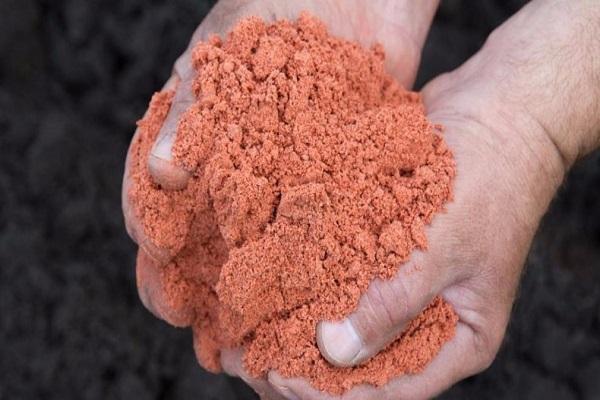
Fencing
Miscanthus cultivars prone to overgrowth can be restricted around the perimeter. The roots of the plant do not go deep, so it is quite easy to stop their growth. For this, metal sheets are suitable, recessed by about 20-25 cm.
Weeding
After each watering, the soil at the roots of miscanthus must be loosened, and the weeds must be completely removed. It is important to weed the plants frequently during the period of active growth so that the weeds do not take nutrients and slow down the growing season.
To reduce the number of weeds, the soil around the miscanthus can be mulched with dry crushed peat.
Preparing for winter
It is better to cover Miscanthus for the winter to avoid hypothermia of the roots. After the end of the growing season, the soil is mulched abundantly. An impromptu hut is made around the plant, covered with a film or other material. It should not be too tight to allow air to pass through.

Reproduction
Miscanthus grows well for several years, but over time it loses its density in the central part. In this case, it must be transplanted or replaced with a new one. Grain does not tolerate transplantation, and it must be propagated with care. Miscanthus can be bred in two ways:
- seed;
- vegetative, by dividing the bush.
Dividing the bush
The vegetative method is used most often for the propagation of miscanthus. It is not recommended to divide the rhizome of the bush more often than once every 3 years, so that it has time to grow new roots. The procedure is carried out in late spring or early summer, when the growth of young stems has begun.
It is recommended to plant the split pieces on the same day that they are dug, but if necessary, store the miscanthus in a cool place for several days before dividing and planting.
Seeds
Seed propagation of miscanthus is difficult in the middle zone and northern regions. The grains do not have enough summer warmth to fully mature. However, most gardeners prefer to use commercially available planting material, since collecting small seeds is not easy. The use of the seed propagation method is also complicated by the fact that the bush acquires a beautiful appearance after at least 3 years. Grain pretreatment is not required, but at first seedlings are grown from them in single planting containers.

Diseases and pests
Miscanthus has strong immunity and is not susceptible to disease. Pests of horticultural crops also do not find it attractive. In order to completely eliminate the possibility of infection, plants should be treated with fungicides. Preventive spraying against rot and rust is carried out in spring and autumn, before the beginning of the growing season and at the end of it.
Using
Miscanthus is actively used in landscape design of personal plots. Florists include dry panicles in bouquets and compositions. And some countries are actively cultivating miscanthus for industrial purposes in order to use it as biofuel.
In landscape design
Decorators use miscanthus to decorate the shores of water bodies. Tall plants are planted to form a dense backdrop for bright, stunted flowers. Single shrubs are used to accentuate lawns as well as natural fencing. It is sometimes planted in a mixture with other herbs to create colorful mixes.

Fuel for power plants
Miscanthus is classified as a biofuel crop that is capable of giving off a large amount of thermal energy when burned. High efficiency has been proven by numerous studies, according to the results of which a wave of construction of corresponding power plants took place in Europe and China. Also, the cultivation of miscanthus has a positive effect on the quality of the soil, clearing it of radiation and heavy metals.
Reviews
Ekaterina: “I took Miscanthus from a friend, it has been growing with me for the third year already. Unpretentious, but appreciates water and fertilizers. "

Evgeniy: “In the Moscow region, Chinese Miscanthus has been growing for about 12 years, blooming in August-September with silvery panicles. It tolerates winter well and did not freeze even in snowless conditions. "
Elena: “I have been growing the Strictus variety for almost 4 years, and I really like it. The bush is compact, does not spread and retains its beauty even in winter. Dry panicles also last very long and look good. "

